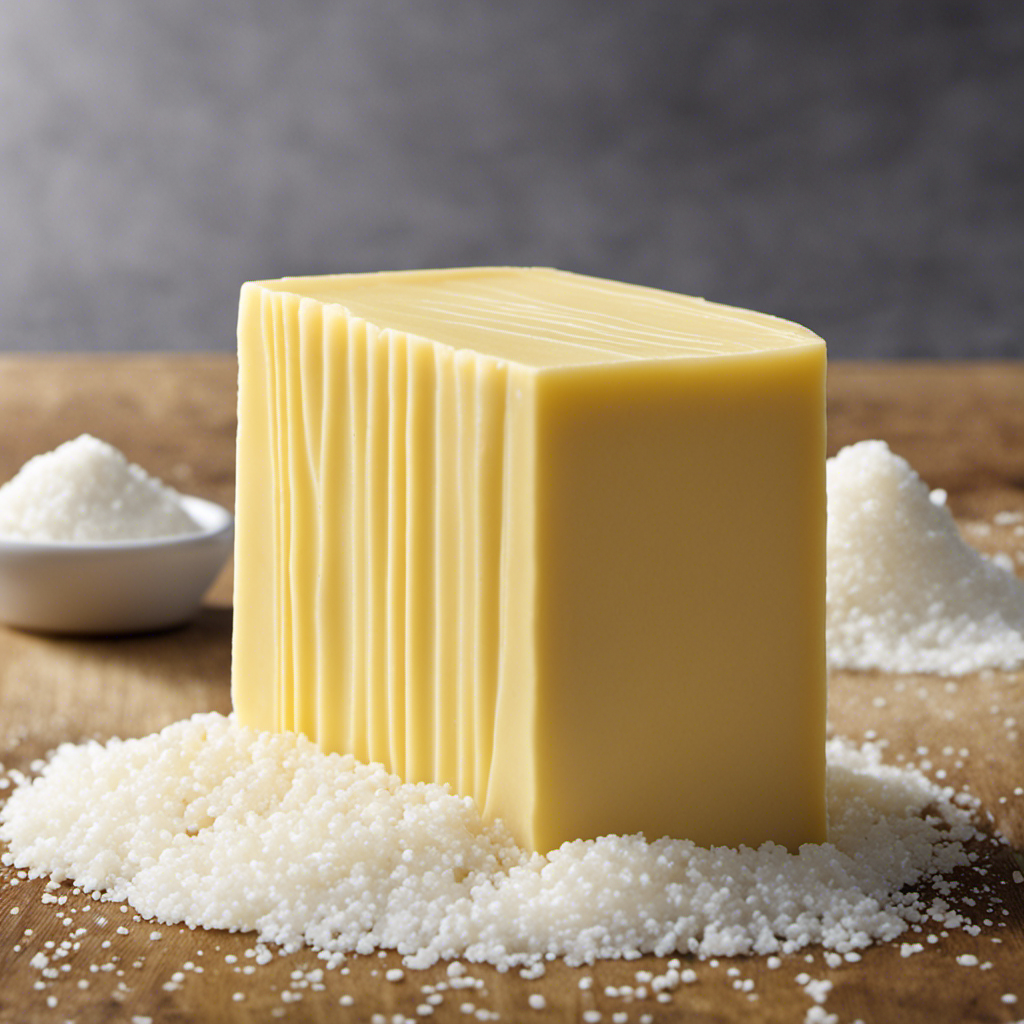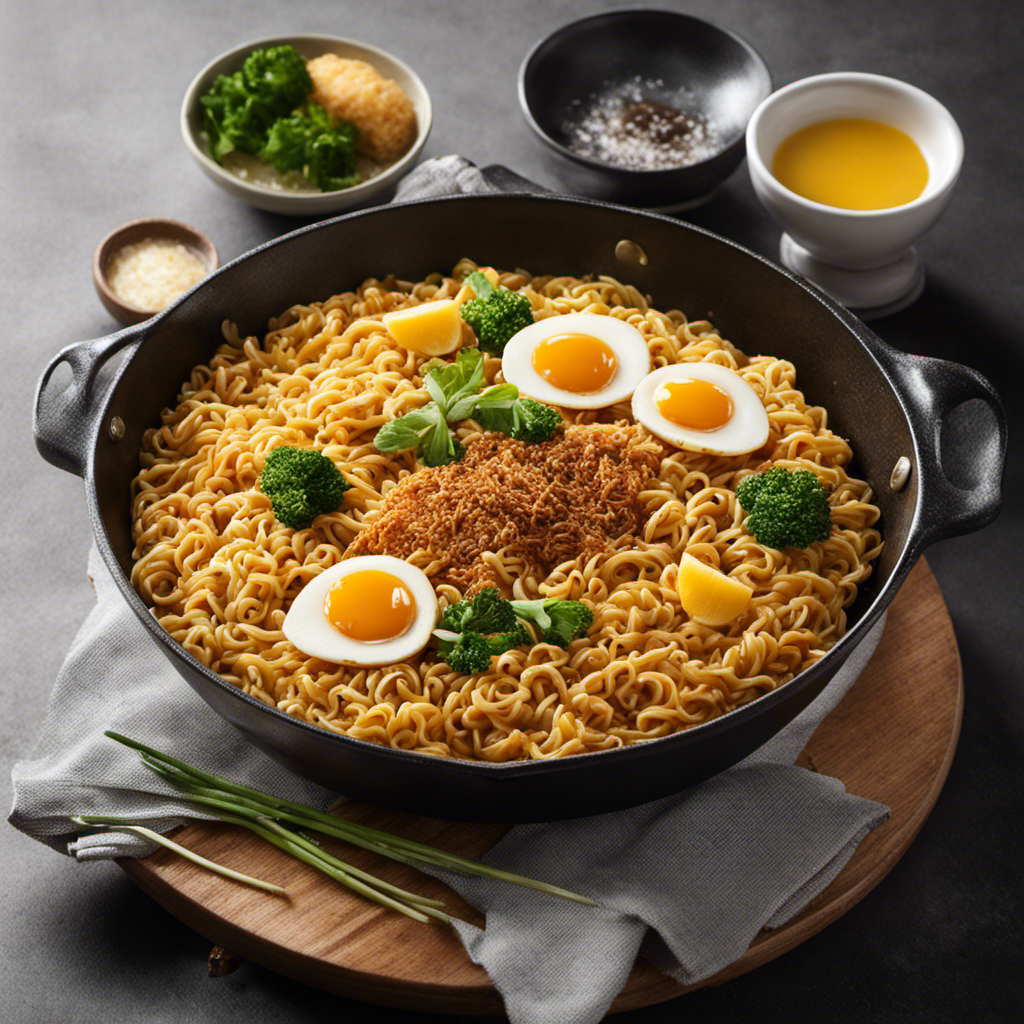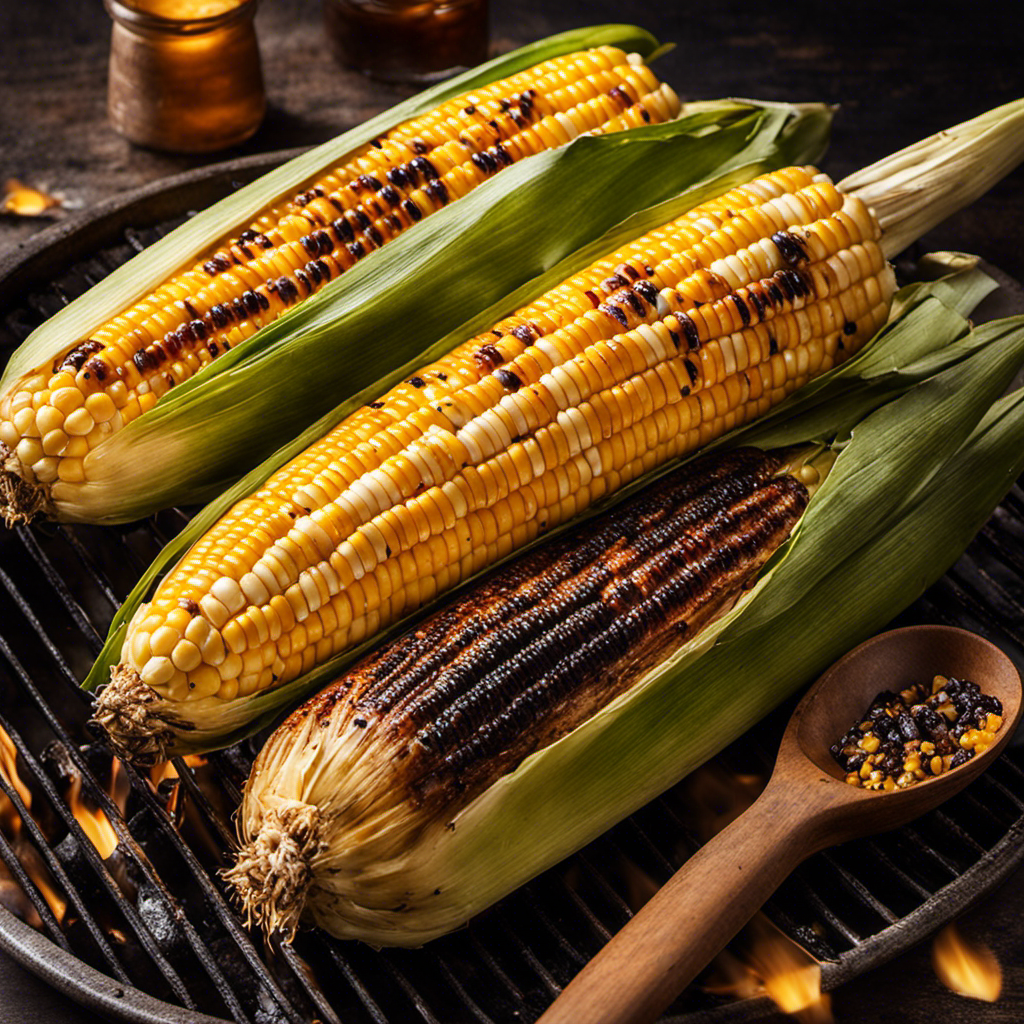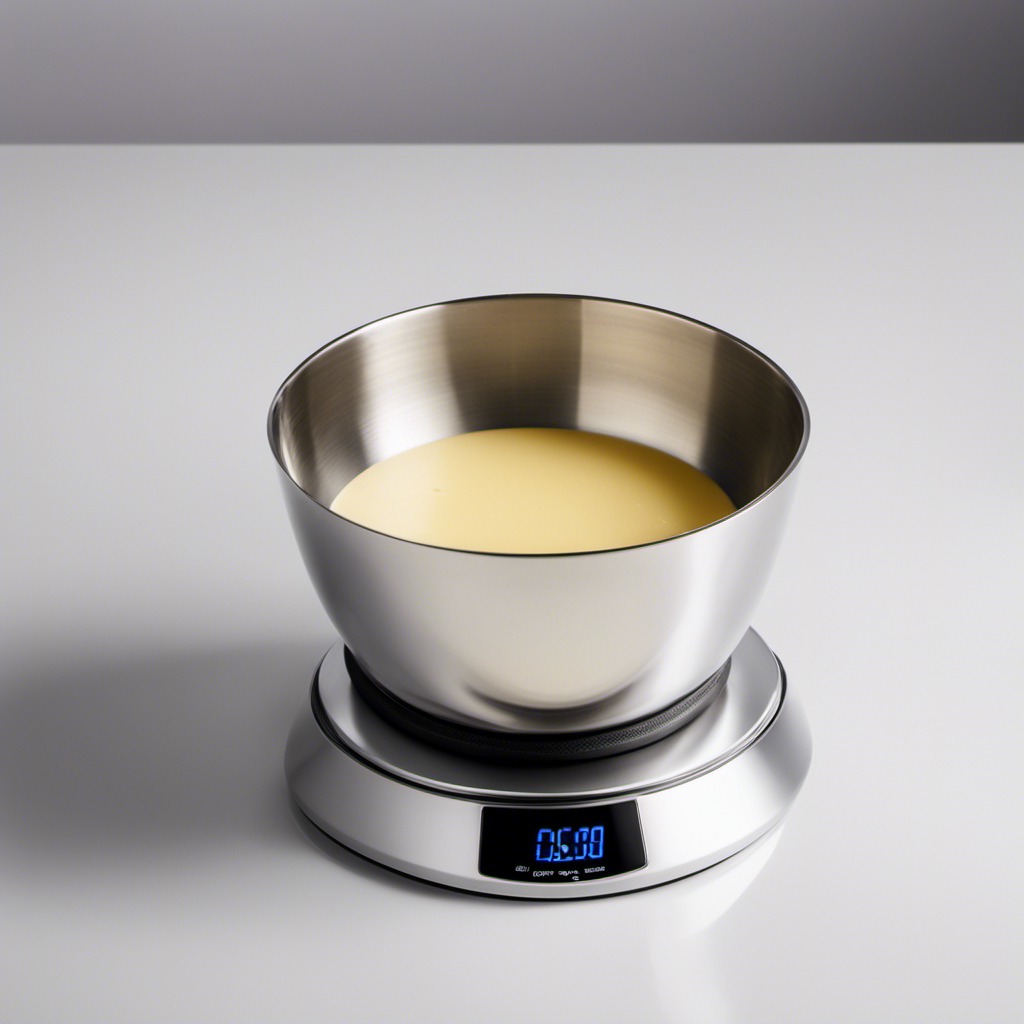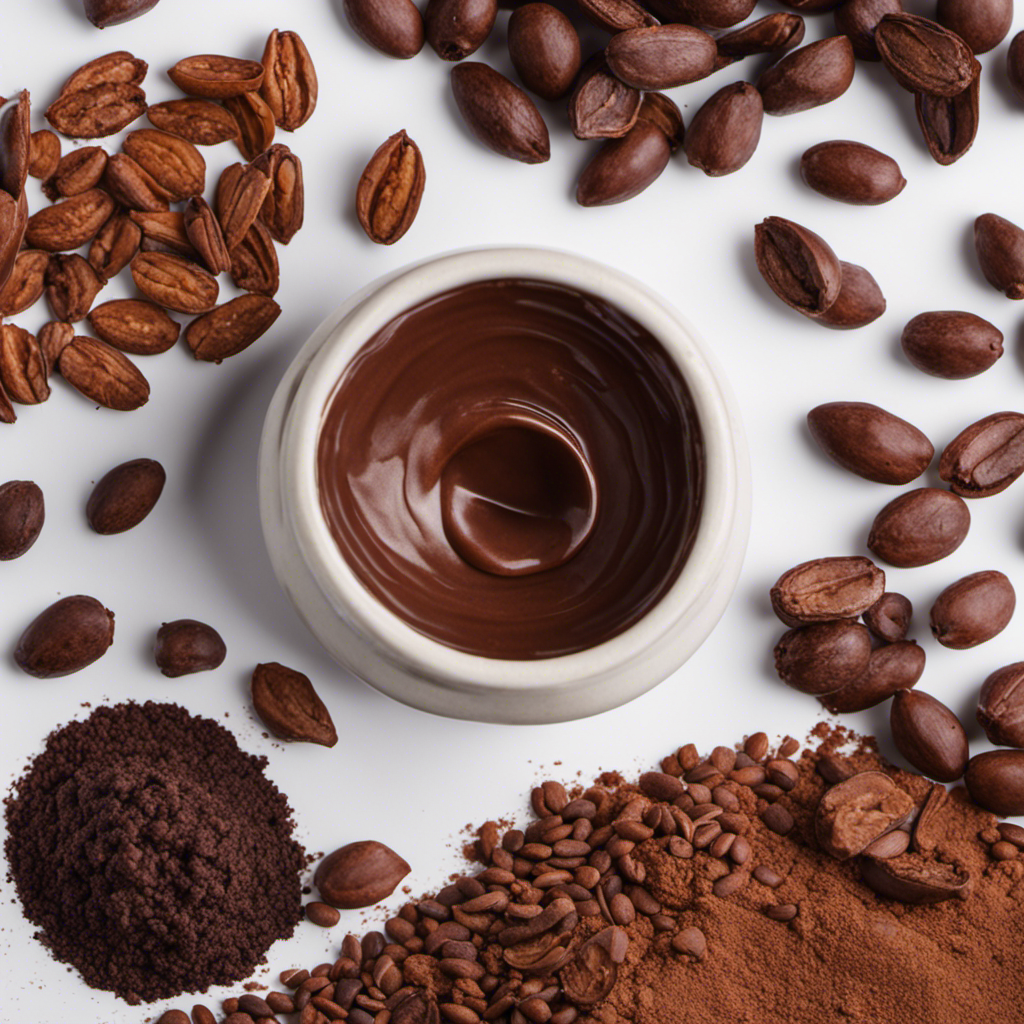Have you ever stopped to think about how much salt is actually present in that seemingly harmless stick of butter in your refrigerator? Let me share some surprising news with you.
In this article, I’ll be diving deep into the world of butter composition and sodium content. We’ll explore the intricate relationship between salt and butter, compare the sodium levels in salted and unsalted versions, and even examine how a high sodium diet can impact your health.
So get ready to make informed choices about your butter consumption and discover some practical tips for reducing sodium in your favorite butter-based recipes.
Let’s butter up our knowledge and get started!
Key Takeaways
- Butter can contain varying amounts of salt, typically around 1-2% or 1-2 grams per 100 grams of butter.
- Salted butter contains about 90 milligrams of sodium per tablespoon, while unsalted butter contains little to no sodium.
- High sodium intake has been linked to health issues such as high blood pressure and an increased risk of heart disease.
- Low-sodium spreads made with heart-healthy oils like olive or canola oil can be a healthier alternative to butter, especially for those watching their sodium intake.
Understanding Butter Composition
You’ll need to understand the composition of butter to determine how much salt is in a stick.
Butter is primarily made up of milk fat, water, and milk solids.
The amount of salt added to butter can vary depending on the brand or type of butter.
Salted butter typically contains around 1-2% salt.
This means that for every 100 grams of salted butter, you can expect to find 1-2 grams of salt.
It’s important to note that unsalted butter does not contain any added salt.
For those watching their sodium intake, choosing unsalted butter can be a good option.
When it comes to overall sodium in food, it’s important to consider not just the butter, but also other ingredients and dishes in your meal.
Butter as a Source of Sodium
When it comes to butter, one important factor to consider is its sodium content. High sodium intake has been linked to various health issues, such as high blood pressure and an increased risk of heart disease.
Therefore, it is crucial to be aware of the amount of sodium in butter and explore low-sodium alternatives that can still provide the desired flavor and texture in cooking and baking.
Sodium Content in Butter
If you’re watching your sodium intake, be aware that a stick of butter contains a significant amount of salt. Here’s a breakdown of the sodium content in butter:
-
Salted Butter: Salted butter typically contains about 90 milligrams of sodium per tablespoon. This can add up quickly, especially when using larger quantities in baking or cooking.
-
Unsalted Butter: Unsalted butter, on the other hand, contains little to no sodium. It’s a better option if you’re looking to reduce your sodium intake.
-
Baking: When baking, keep in mind that if a recipe calls for salted butter, you may need to adjust the amount of added salt to maintain the desired flavor.
-
Spreads: Butter spreads, like margarine, can vary in their sodium content. It’s important to check the nutrition label to make an informed choice.
Overall, if you’re aiming to reduce your sodium intake, it’s worth considering the sodium content in butter and opting for unsalted varieties when possible.
Health Implications of Butter
The health implications of butter include its impact on cholesterol levels and heart health. Butter is known to be high in saturated fat, which can raise LDL cholesterol levels, also known as ‘bad’ cholesterol. High levels of LDL cholesterol in the blood can increase the risk of heart disease and stroke.
It is recommended to limit saturated fat intake to reduce the risk of these conditions. However, it is important to note that not all fats are created equal. Butter also contains some beneficial nutrients like vitamins A, D, E, and K.
Moderation is key when it comes to consuming butter. Consider using healthier alternatives like olive oil or avocado spread, which are lower in saturated fat and have been associated with lower risk of heart disease.
Low-Sodium Butter Alternatives
Consider opting for low-sodium spreads as a healthier alternative to butter. Not only do these spreads provide a flavorful twist to your recipes, but they also offer several benefits over traditional butter. Here are four reasons why you should consider incorporating low-sodium spreads into your baking recipes:
-
Reduced Sodium Intake: Low-sodium spreads contain significantly less sodium than butter, making them a better choice for individuals looking to lower their sodium intake.
-
Heart-Healthy Option: Many low-sodium spreads are made with heart-healthy oils, such as olive or canola oil, which can help lower cholesterol levels and reduce the risk of heart disease.
-
Versatility: Low-sodium spreads can be used in a variety of baking recipes, from cookies to cakes, without compromising on taste or texture.
-
Customizable Flavor: With low-sodium spreads, you can easily customize the flavor profile of your baked goods by adding herbs, spices, or even citrus zest.
The Relationship Between Salt and Butter
There’s a direct relationship between salt and butter, affecting the overall taste. Salt plays a crucial role in butter production, as it acts as a preservative and enhances flavor. When salt is added to butter, it not only helps to extend its shelf life but also brings out the natural creamy and rich taste.
The addition of salt in butter provides a balanced flavor profile that enhances the taste of various dishes, from baked goods to savory dishes like pasta or vegetables. Moreover, salted butter benefits include its ability to enhance the overall taste and add a subtle savory note to recipes.
However, for those concerned about their sodium intake, it’s important to consider the sodium content in unsalted butter, which will be discussed in the following section.
Sodium Content in Unsalted Butter
In my previous discussion about the relationship between salt and butter, I mentioned that salted butter contains sodium. Now, let’s dive deeper into the sodium content in unsalted butter.
Here are some key points to consider:
-
Sodium in Salted Butter: Salted butter typically contains around 90 milligrams of sodium per tablespoon.
-
Sodium Content in Cooking Butter: Unsalted butter, on the other hand, does not have any added salt, which means it has a much lower sodium content.
-
Natural Sodium: While unsalted butter does contain a small amount of naturally occurring sodium, the levels are significantly lower than in salted butter.
-
Health Considerations: If you are watching your sodium intake, using unsalted butter in your cooking and baking can be a good option.
Now that we have explored the sodium content in unsalted butter, let’s move on to the next section and compare salted and unsalted butter.
Comparing Salted and Unsalted Butter
When comparing salted and unsalted butter, you should take into account the difference in taste and versatility.
Salted butter has a distinct flavor due to the added salt, which enhances its taste and makes it more savory. This can be particularly beneficial when using butter in recipes that require a savory element, such as sautéing vegetables or making sauces.
On the other hand, unsalted butter provides a neutral base and allows for more control over the salt content in your dishes. This versatility is especially important when baking, as it gives you the freedom to adjust the salt levels according to your preference.
Additionally, unsalted butter is often preferred when making butter-based frostings or icings, as it allows the other flavors, such as butter flavoring or extracts, to shine through without interference from the salt.
Ultimately, the choice between salted and unsalted butter depends on personal preference and the specific culinary application.
How Salt Is Added to Butter
When it comes to butter, the ratio of salt to butter is an important factor to consider. The salted vs. unsalted debate often revolves around personal preference and the desired level of saltiness in dishes.
Understanding how salt is added to butter can shed light on the differences and help in making an informed choice.
Salt: Butter Ratio
To determine the ratio of salt to butter, you can simply divide the amount of salt by the amount of butter. This will give you a clear understanding of how much salt is in a stick of butter.
Here are some key points to help you understand the butter seasoning and alternatives to salted butter:
-
Salt to butter ratio: The ratio of salt to butter can vary depending on personal preference and the recipe you’re using. Generally, it is recommended to use about 1/4 teaspoon of salt for every 1/2 cup (1 stick) of butter.
-
Salted butter alternatives: If you’re looking for a lower sodium option or prefer unsalted butter, you can add your preferred seasoning to unsalted butter. This allows you to control the amount and type of seasoning added, such as herbs, spices, or even flavored salts.
-
Experiment with different seasonings: Don’t be afraid to get creative with your butter seasoning. Try adding garlic, herbs like rosemary or thyme, or even a pinch of smoked paprika to give your butter a unique flavor.
-
Taste and adjust: When using butter seasoning, always taste and adjust as needed. Start with a small amount and gradually add more until you achieve the desired taste. Remember, it’s easier to add more seasoning than to remove it if you’ve added too much.
Salted Vs Unsalted
In my previous discussion about the salt-to-butter ratio, I mentioned that salted and unsalted butter have different amounts of sodium. Now, let’s delve deeper into the topic of salted versus unsalted butter.
Salted butter is simply butter that has been seasoned with salt. It typically contains about 1.6% to 1.7% salt by weight. This means that for every 100 grams of salted butter, you would find around 1.6 to 1.7 grams of sodium.
On the other hand, unsalted butter contains no added salt, making it a sodium-free alternative.
If you are concerned about your sodium intake or if you simply prefer to control the amount of salt in your recipes, using unsalted butter is a great option. You can always add your own salt or experiment with sodium alternatives like herbs, spices, or even low-sodium seasoning blends to enhance the flavor of your dishes.
Salt Distribution Process
If you’re curious about the process of distributing salt throughout butter, you might be interested to know that it involves thoroughly mixing the salt into the butter during production. This ensures that the salt is evenly distributed, providing a consistent flavor in every bite.
Here is a breakdown of the salt distribution process and its impact on butter flavor:
-
Mixing: Salt is carefully measured and added to the butter. The butter and salt are mixed together using specialized equipment, ensuring that the salt is evenly distributed throughout the entire batch.
-
Homogenization: The mixture is further processed to ensure a uniform texture and consistency. This helps to distribute the salt particles even more evenly, enhancing the flavor profile.
-
Chilling: After the mixing process, the butter is chilled to solidify it. This helps to preserve the distribution of the salt and maintain its flavor.
-
Flavor enhancement: The salt distribution process enhances the overall taste of the butter, providing a perfect balance of saltiness that complements various dishes.
The careful distribution of salt throughout the butter during production plays a crucial role in creating a flavorful and enjoyable culinary experience.
Reading the Nutrition Label of Butter
Check the nutrition label on the stick of butter to see how much salt is included.
Understanding sodium intake is crucial for maintaining a healthy lifestyle. High sodium consumption has been linked to numerous health problems, including hypertension and cardiovascular disease.
By reducing our sodium intake, we can reap several benefits. Lowering sodium levels can help lower blood pressure, reduce the risk of strokes, and improve overall heart health. It can also help prevent water retention and decrease the likelihood of developing kidney stones.
Reading the nutrition label on butter can give us insight into our sodium intake and allow us to make informed decisions about our diet. Opting for reduced-sodium butter or using alternatives like olive oil can be a practical way to reduce our sodium intake and improve our overall health.
Recommended Daily Sodium Intake
When it comes to sodium consumption, it’s important to be aware of safe limits and the potential health risks of excess sodium.
As an informed individual, understanding the recommended daily sodium intake can help you make healthier choices and prevent potential health issues.
In this discussion, we will explore the safe sodium consumption limits and the various health risks associated with consuming too much sodium.
Safe Sodium Consumption Limits
There’s a maximum limit for safe sodium consumption. It’s important to be mindful of how much sodium we consume daily to maintain good health. Here are some practical tips to help you stay within safe limits:
-
Choose butter alternatives: Butter is high in sodium, with about 90 milligrams per tablespoon. Opt for alternatives like olive oil or avocado spread, which have lower sodium content.
-
Check sodium in other dairy products: Butter is not the only dairy product that contains sodium. Cheeses, for example, can have varying amounts of sodium, so be sure to read labels and choose lower sodium options.
-
Limit processed foods: Processed foods, such as canned soups and frozen meals, are often loaded with sodium. Opt for fresh, whole foods whenever possible to reduce your sodium intake.
-
Be mindful of condiments: Many condiments, like ketchup and soy sauce, are high in sodium. Use them sparingly or look for low-sodium alternatives.
Health Risks of Excess Sodium
Excess sodium can lead to various health risks, so it’s important to monitor your intake. Consuming too much sodium can have long-term effects on our health. It can increase the risk of high blood pressure, which in turn can lead to heart disease and stroke. Additionally, excessive sodium intake has been linked to kidney damage, osteoporosis, and even stomach cancer. To illustrate the impact of excessive sodium intake, let’s take a look at the following table:
| Health Risks of Excessive Sodium |
|---|
| High blood pressure |
| Heart disease |
| Stroke |
| Kidney damage |
| Osteoporosis |
| Stomach cancer |
Impact of High Sodium Diet on Health
If you consume too much salt, it can negatively affect your health. High sodium diets have a significant impact on cardiovascular health and can lead to various health problems.
Here are four key ways excessive salt intake can harm your health:
-
Increased blood pressure: Consuming too much salt can raise your blood pressure, putting a strain on your heart and increasing the risk of heart disease and stroke.
-
Risk of kidney disease: High sodium diets can impair kidney function and contribute to the development of kidney disease over time.
-
Fluid retention: Excessive salt intake can cause your body to retain fluid, leading to swelling in the legs, ankles, and feet.
-
Increased risk of stomach cancer: Studies have shown a link between high sodium diets and an increased risk of stomach cancer.
To maintain good health, it’s important to limit your salt intake and opt for healthier alternatives when seasoning your food.
Sodium Content in Different Brands of Butter
When choosing a brand of butter, you should be aware of the sodium content in order to make a healthier choice. Sodium is a mineral that plays a crucial role in our body’s fluid balance and nerve function. However, consuming too much sodium can lead to high blood pressure and other health issues. Flavored butters, such as garlic or herb-infused varieties, often contain higher levels of sodium compared to regular unsalted butter. The added salt enhances the flavor but also increases the sodium content. To make a more informed decision, it’s important to check the nutrition labels and compare the sodium content of different butter brands. Here is a table highlighting the sodium content in some popular butter brands:
| Butter Brand | Sodium Content per Serving |
|---|---|
| Brand A | 100mg |
| Brand B | 150mg |
| Brand C | 200mg |
| Brand D | 250mg |
| Brand E | 300mg |
Tips for Reducing Sodium in Butter-based Recipes
To cut down on sodium in butter-based recipes, consider using alternative seasonings and herbs for added flavor. Not only will this help reduce the sodium content, but it will also provide a healthier option for your dishes. Here are four tips to help you achieve this:
-
Experiment with herbs: Instead of relying solely on salt for flavor, try using herbs like basil, thyme, or rosemary. These can add depth and complexity to your dishes without the need for excessive sodium.
-
Use citrus juices: Lemon or lime juice can provide a tangy and refreshing flavor to your recipes. They work especially well in savory dishes, balancing out the richness of butter without the need for additional salt.
-
Incorporate spices: Spices like paprika, cumin, or chili powder can bring a wealth of flavors to your butter-based dishes. They can add a kick of heat or a subtle smokiness, reducing the need for sodium.
-
Opt for low-sodium alternatives: If you’re looking for a healthier butter alternative, consider using spreads or margarines that are lower in sodium content. These options can still provide the creamy texture and rich taste you desire, but with less sodium.
Conclusion: Making Informed Choices About Butter Consumption
In conclusion, it’s important to make informed choices about your butter consumption in order to prioritize your overall health.
When it comes to making healthy butter choices, understanding sodium intake is crucial. Butter is a delicious and versatile ingredient, but it can also be high in sodium. By being aware of the sodium content in butter, you can make smarter decisions about how much to use in your cooking and baking.
Opting for unsalted butter or low-sodium alternatives can significantly reduce your sodium intake without sacrificing flavor. Additionally, it’s important to balance your butter consumption with other sources of healthy fats, such as olive oil or avocado. Moderation is key.
Frequently Asked Questions
Can I Substitute Unsalted Butter for Salted Butter in a Recipe?
Yes, you can substitute unsalted butter for salted butter in a recipe. However, keep in mind that the absence of salt may impact the overall flavor of the dish. Adjust the amount of salt accordingly to maintain the desired taste.
How Does the Sodium Content in Butter Compare to Other Sources of Sodium in the Diet?
Reducing sodium intake in our diet is beneficial for health. When comparing sodium content, it’s important to note that other dairy products, like cheese, can have higher levels than butter.
Does the Amount of Salt in Butter Vary Between Different Brands?
The amount of salt in butter can vary between different brands. It’s important to read the nutrition labels to compare the sodium content. Salt can have an impact on the flavor of butter.
Can I Reduce the Sodium Content in Butter by Rinsing It With Water?
Sure, I can reduce the sodium in butter by rinsing it with water. It’s a simple technique that helps remove some of the salt. Just be careful not to overdo it and wash away all the flavor.
Are There Any Health Risks Associated With Consuming Too Much Sodium From Butter?
Consuming butter in moderation has health benefits, but high sodium intake can negatively impact heart health. It’s important to be mindful of sodium content in butter and other foods to maintain a balanced diet.
Conclusion
In conclusion, after exploring the sodium content in a stick of butter, it’s clear that there is a significant difference between salted and unsalted varieties.
While unsalted butter contains minimal sodium, salted butter can contribute to a high sodium intake.
It’s important to be mindful of our sodium consumption, as excessive amounts can negatively impact our health.
By choosing unsalted butter or reducing salt in butter-based recipes, we can make more informed choices about our butter consumption.
Remember, a little goes a long way when it comes to butter!
